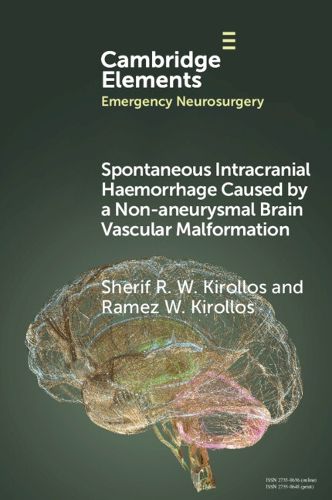Readings Newsletter
Become a Readings Member to make your shopping experience even easier.
Sign in or sign up for free!
You’re not far away from qualifying for FREE standard shipping within Australia
You’ve qualified for FREE standard shipping within Australia
The cart is loading…






Emergency management of intracranial haemorrhage due to AVMs, DAVFs, and cavernomas involves addressing both the haemorrhage consequences and the underlying vascular lesion. Clinical evaluation and diagnostic workup identify factors necessitating urgent intervention and define the vascular lesion. Urgent intervention may involve ICH management with increased ICP or CSF drainage for acute hydrocephalus. Definitive intervention for the vascular lesion may coincide with or follow evacuation of the intracranial haematoma. Careful considerations and precautions are taken independently or concurrently with the vascular lesion. Indications and timing for AVM intervention involve determining the bleeding source, evaluating mass effect, and assessing the utility of existing ICH for microsurgical AVM resection. Modified microsurgical techniques ensure safety. DAVF intervention with ICH or ASDH requires urgent endovascular treatment and surgical nuances. Cavernoma intervention follows straightforward indications and timing, while brainstem cavernomas require careful consideration of early intervention. Aftercare and a team approach are vital.
$9.00 standard shipping within Australia
FREE standard shipping within Australia for orders over $100.00
Express & International shipping calculated at checkout
Emergency management of intracranial haemorrhage due to AVMs, DAVFs, and cavernomas involves addressing both the haemorrhage consequences and the underlying vascular lesion. Clinical evaluation and diagnostic workup identify factors necessitating urgent intervention and define the vascular lesion. Urgent intervention may involve ICH management with increased ICP or CSF drainage for acute hydrocephalus. Definitive intervention for the vascular lesion may coincide with or follow evacuation of the intracranial haematoma. Careful considerations and precautions are taken independently or concurrently with the vascular lesion. Indications and timing for AVM intervention involve determining the bleeding source, evaluating mass effect, and assessing the utility of existing ICH for microsurgical AVM resection. Modified microsurgical techniques ensure safety. DAVF intervention with ICH or ASDH requires urgent endovascular treatment and surgical nuances. Cavernoma intervention follows straightforward indications and timing, while brainstem cavernomas require careful consideration of early intervention. Aftercare and a team approach are vital.